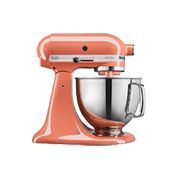Bowl Oxidization - Stand Mixer
Possible Solutions
What causes rust?
While stainless steel is rust-resistant, it isn't 100% rust proof. Several things can cause rust on even the highest quality stainless steel.
Unlike carbon steel, stainless steel is an iron alloy that contains a relatively high percentage of chromium. It's the inclusion of chromium that gives stainless steel its rust resistance. The chromium in stainless steel reacts with oxygen (in the air or water) to form a very thin, transparent, passive film (chromium oxide) over the surface of the steel, which limits further oxidation (rust).
This passive film is formed (and repaired) very rapidly, so you don't need to worry about scraping or scrubbing it off. But some things can penetrate this film and cause rust if left in contact with stainless steel.
How do you prevent rust?
Frequent washing is an essential step, but there are a few other tips and tricks to keep in mind.
Some city water sources contain high levels of chlorine, which can penetrate the protective film on stainless steel and cause rusting. Well water can also include a bacteria that is capable of producing rust in stainless steel.
Avoid Scratches
Small scratches are mostly cosmetic, but deeper scratches can be difficult to keep clean. Avoid scratches by not using metal utensils in your bowls (or using them very gently) and staying away from highly abrasive pads.
Use the Correct Soap
Use only mild detergents and steer clear of harsh chemicals or antibacterial cleaning products. Some harsh chemicals and antibacterial soaps can cause rusting in stainless steel. Halogen salts (chlorine, fluorine, bromine, iodine), some antibacterial agents (ones that contain a chemical called Triclosan), and bleach (sodium hypochlorite) or bleach-containing cleaning products may cause rust in stainless steel. Check your soap and make sure it doesn't contain any of these materials.
Avoid Metal on Metal Contact
Avoid metal cleaning pads (like steel wool) and avoid metal utensils. Steel wool is made from carbon steel and rusts readily. Using it on a stainless steel material can deposit what is referred to as "free iron", which isn't protected by chromium, and can quickly lead to rusting. Sustained contact between stainless steel and some other types of metal can set-up a process called Galvanic Corrosion. A wet environment is far more likely to lead to rusting than a drier climate.
How to Remove Rust and Stains?
For rust removal
- Mix some baking soda with vinegar (apple cider or white vinegar) until you reach the consistency of a paste.
- Spread the paste over the surface of the stainless steel
- Allow it to sit for about 10 minutes (up to a few hours if you have very stubborn rust).
- Scrub the paste over the stainless steel surface with a scratch-free scrubbing pad using a circular motion.
- Rinse the bowl thoroughly with warm water, then perform a regular soap and water wash followed by a hand drying.
This more in-depth cleaning process can be used as needed (when stains or rust appear) or on a weekly/monthly basis as a preventative action.
Still need help? Contact us or schedule service.
Please contact us or click below to make an appointment from our preferred list of service providers for service on your appliances.
United States
Canada
Interested in purchasing an Extended Service Plan?
Please click below to learn more on how you can save up to 25% on New Appliance Extended Service Plans within 30 days of your appliance purchase.
United States
Canada










.png)

























